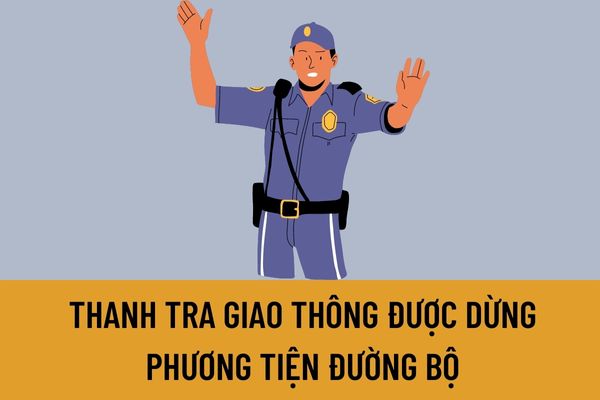In what cases can the traffic inspector stop a road vehicle in Vietnam? How is the road vehicle stop signal regulated?
In what cases can the traffic inspector stop a road vehicle in Vietnam?
Pursuant to Article 15 of Circular 02/2014/TT-BGTVT stipulating cases in which road vehicles are allowed to stop are as follows:
- Forcing to stop acts of violations as prescribed in Article 55 of the 2012 Law on Handling of Administrative Violations in Vietnam.
- When detecting a vehicle with signs specified at Point a, Clause 2, Article 86 of the 2008 Law on Road Traffic of Vietnam, specifically as follows:
+ Exceeding the allowable load of bridges and roads;
+ Exceeding the allowable size limit of bridges and roads;
+ Crawler vehicles circulate directly on the road without taking measures to protect the road as prescribed;
+ Illegally dumped soil, construction materials and other scraps onto roads or into road safety corridors.
Thus, the traffic inspector is entitled to stop the road vehicle in the above cases.

In what cases can the traffic inspector stop a road vehicle in Vietnam? How is the road vehicle stop signal regulated?
How is the signal to stop a road vehicle regulated?
Pursuant to Clause 1, Article 16 of Circular 02/2014/TT-BGTVT stipulating vehicle stop signals include:
- Traffic command stick or STOP mandatory sign.
- Whistle, portable battery speaker, vehicle-mounted electric speaker
- Barie or barrier.
Pursuant to Clause 2, Article 16 of Circular 02/2014/TT-BGTVT and Clause 3, Article 16 of Circular 02/2014/TT-BGTVT stipulating the order to stop vehicles as follows:
Signal to stop the vehicle with a traffic stick or a STOP mandatory sign when an inspector or an inspection officer stands on the road, specifically as follows:
- Inspectors, inspection officials stand at a safe position and the vehicle driver can observe, face towards the traffic vehicle showing signs of violation, right hand holding a stick to command traffic (or STOP mandatory sign) parallel to the ground, palm holding the traffic signal stick (or STOP mandatory sign) in an upright position;
- When the vehicle driver receives the signal and slows down, the inspector, the inspector shall use the traffic command stick or the STOP mandatory sign in combination with the horn signal to guide the vehicle to park in the appropriate and safe position to perform the inspection.
Signaling to stop the vehicle with a traffic stick or a STOP mandatory sign when an inspector or inspection officer is sitting on the vehicle, specifically as follows:
- Inspectors, inspectors holding traffic command sticks or STOP mandatory signs to cross over to the side of the vehicle showing signs of violation so that the vehicle operator can see it.
- In case the inspection force's vehicle goes in the same direction and there are signs of violation behind the vehicle, the inspector, inspection officer or employee shall use loudspeakers to request the vehicle driver to stop.
What are the tasks and powers of the road inspector when stopping a vehicle?
Pursuant to Clause 4, Article 16 of Circular 02/2014/TT-BGTVT and Clause 5, Article 16 of Circular 02/2014/TT-BGTVT stipulating the tasks and powers of road inspectors when stopping vehicles are as follows:
- When the vehicle stops at the location as instructed, the inspector or inspection officer requests the driver to get off the vehicle and present documents for inspection; when necessary, carry out weighing, measuring, counting and checking documents to determine the axle load, total weight of the vehicle, size of goods, size limit of the vehicle; At the same time ask the driver to coordinate to check.
- Depending on the violation, the inspector or the inspection officer shall request the vehicle operator to immediately unload the overloaded part, unload the oversized part, install the clogs on the crawler or immediately move the land and construction materials, other waste illegally dumped; make records, sanction administrative violations, force restore the original state according to the provisions of law.
- Inspectors and inspectors shall report to their direct management on the time, place and number of vehicles stopped at the end of the work plan.
What are the tasks and powers of the road inspectorate in Vietnam?
Pursuant to Clause 2, Article 86 of the 2008 Law on Road Traffic of Vietnam, the road inspectorate in Vietnam has the following tasks and powers:
- To inspect, detect, stop and sanction administrative violations in the observance of legal provisions on protection of road infrastructure, assurance of technical standards of road works; in urgent cases, in order to prevent possible consequences on road works, to stop vehicles and ask their operators to take measures to protect works in accordance with law and take responsibility for such decisions;
- To inspect, detect, stop and handle administrative violations in the observance of regulations on transportation activities and transportation support services at standing and parking points along roads, car terminals, parking lots, roadside service stations, vehicle mass inspection stations, toll stations and at road transportation enterprises;
- To inspect, detect, stop and sanction violations in driver training and examination, the grant, renewal and withdrawal of driver licenses, and the technical safety and environmental protection inspection of motor vehicles. The inspection and examination of army and police car drivers, and the grant, renewal and withdrawal of their driver licenses shall be stipulated by the Minister of Defense and the Minister of Public Security;
- To perform other tasks and exercise other powers according to the inspection law.
LawNet
